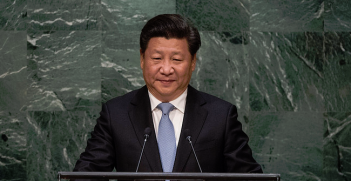India's Demands Grind Nepal to a Standstill
Nepal promulgated its federal Constitution on September 20, defying India’s diplomatic efforts. Since then, India has stepped up its threats for amendments to suit its interests, resulting in an ongoing unofficial economic blockade against Nepal.
The blockade imposed by India has crippled the Nepalese economy, cutting out basic life supporting supplies, such as food, medicines, petroleum and other daily essentials, all of them imported from the Indian border states. The blockade has stalled post-earthquake reconstruction works; schools and factories are shut; transport services have completely come to halt; international airlines have almost closed their flights due to the shortage of aviation fuel; and the price of basic necessities has soared. The estimated losses are $1 billion to the country’s economy and are having a knock-on effect on potential investment and growth. This has come ahead of Nepal’s biggest festive season, starting next week.
India has been supporting a federal structure in Nepal to conform to its long term strategic and security interests. India initially supported the ‘One Madhes One Province’ structure in Nepal, with the merging of 22 districts into one province of low-lying land of Terai-Madhes adjoining the border states of India. Later on, it showed a little more flexibility by agreeing to the division of the provinces into two provinces.
This kind of province structure within Nepal would have increased India’s leverage in strategic and security concerns, as it would have to deal with, at most, two adjoining provinces in its border region. It would also mean smoother dealings with a maximum of two Chief Ministers, rather than a clutter of more than a dozen.
The similarity in cultural, language and matrimonial relationships between Terai’s people and the people of the Indian states of Bihar and Uttar Pradesh could also be cultivated to influence the domestic politics, governance, security, water resources management, border management and to a larger extent Nepal’s foreign policy. Indian foreign policy is strategically in favour of developing Terai-Madhes as an ‘inner buffer’ as it believes that the Himalayas have been penetrated by China through the proposed rail links from Lhasa to Kathmandu and its ‘One Belt One Road’ strategy. This kind of move by China has put former Prime Minister Jawaharlal Nehru’s ‘Strategic Himalayan Frontier’ policy in deep jeopardy. India’s focus is to protect its core constituency within Nepal, the Terai-Madhes region, by developing a pro-Indian province in Nepal.
The signing of a 16-point agreement amongst Nepal’s major political parties on June 8th laid the foundation for the promulgation of the Constitution, including the framework for Nepal’s federal structure. With the pressure from the Terai-Madhes based political parties and Indian quarters to resolve the demarcation of states, the four major political parties had agreed to federate the country into six provinces in an agreement on August 10th, later re-demarcated into seven provinces. However, India expressed its dissatisfaction, by sending Indian Prime Minister Narendra Modi’s special envoy to Nepal, Foreign Secretary S. Jaishankarm, at the last minute to prevent the promulgation of the Constitution. His visit and coercive diplomacy was, however, ill-fated. Nepalese media, politicians and academicians termed his visit ‘ill timed’ to ‘thwart’ the overwhelming majority view, and the government went ahead with the promulgation of the Constitution on September 20th.
The result was an eruption of violence in the Terai-Madhes region, as its population was dissatisfied with the Constitution. India’s official statement on the promulgation of the Constitution used the word ‘noted’ rather than ‘welcomed’, which shows its clear reservations. It was successful in using its diplomatic leverage to influence the United Nations and some Western countries to offer similar statements on Nepal’s Constitution.
The fact remains that the new Constitution of Nepal is actually one of the most progressive constitutions in the world. Provinces have been federated with substantial powers, including guaranteed proportional representation of all groups including Madhesis and other minorities in the State organs.The principles of protection of human rights as fundamental rights, gender equality and their inclusion in governance system is ensured. The principle of citizenship based on nationality of both mother or father is protected, and naturalized citizenship provision is made, amongst other guarantees.
Upon closer scrutiny, the seven province model had undermined India’s strategic and security interests, and India took a hardened stance on Nepal. The Modi Government has pushed Nepal into a virtual state of economic blockade, and seriously harmed long standing special relations by openly supporting the Madhes-centric parties, who have reacted violently, using non-democratic and unconstitutional means to address their demands. These were the tactics used by the Terai-Madhes-based political parties back in 2006-07, which led the then government to bow down to demands to restructure Nepal into a federal structure with the assurance of an ‘Autonomous Madhes Province’. Many believe that this led to the seeds of disintegration in the Terai-Madhes region.
These days, some Terai-Madhes-based political parties, intelligentsia and certain Terai-based armed groups have been openly talking about separating Terai-Madhes from Nepal and merging it with the Indian States of Bihar and Uttar Pradesh or, alternatively, forming an independent nation-state. India has been pressuring Nepal’s government at various levels to address the demands of the Terai-Madhes political parties, or face the consequences. India’s view of Nepal as a ‘buffer’ since the 1950s under Nehru’s strategy produced anti-India sentiments within Nepal and its interest in creating an ‘inner buffer’ in Terai-Madhes in federal Nepal would further intensify this sentiment.
The disintegration of Terai-Madhes as a nation state will bring further instability in the region and will not suit India’s geo-political interests. The present constitution is not rigid and Terai-Madhes based parties should know that it can be amended through legal and constitutional means, rather than by inviting India into the internal affairs of Nepal. Federalism will be a new exercise in Nepal, which can bring either stability or instability. The unification of diverse socio-cultural groups will only help to institutionalise federalism in a sustainable manner.
From an international law perspective, as a land-locked country Nepal is entitled to unrestricted trade and transit rights and India ought not violate these bedrock legal provisions by imposing any form of economic blockade, obstruction or hindrances. Acting aggressively and resorting to legal resolutions are not the routes Nepal seeks to take, on the basis that such action will lead to a ‘trust deficit’ in its special bilateral relations.
Nepal wants to resolve the current crisis in an amicable manner through diplomacy, and, Nepal’s case will test India’s ability to play a more engaged role on the global stage. If India cannot ensure a modicum of stability in its relationships with its sub-continental neighbours like Nepal, there will be doubts about India’s ability to play a responsible global role in the management of regional and international affairs.
Rohit Karki is an Assistant Professor at Kathmandu School of Law, Nepal. He has co-edited the book Geo-Strategic Challenges to Nepal’s Foreign Policy and Way Forward published in 2015 in Kathmandu, Nepal. He holds a Master degree in Asian Studies from the Australian National University. This article can be republished with attribution under a Creative Commons Licence.





